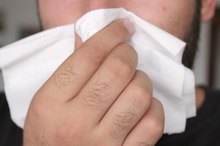What does fact checked mean?
At Healthfully, we strive to deliver objective content that is accurate and up-to-date. Our team periodically reviews articles in order to ensure content quality. The sources cited below consist of evidence from peer-reviewed journals, prominent medical organizations, academic associations, and government data.
The information contained on this site is for informational purposes only, and should not be used as a substitute for the advice of a professional health care provider. Please check with the appropriate physician regarding health questions and concerns. Although we strive to deliver accurate and up-to-date information, no guarantee to that effect is made.
Are Allergies Possible With Magnesium Citrate?
Allergic reactions are possible with any new substance you introduce into your body 2. About 5 to 10 percent of people who introduce a new supplement or drug into their diet experience an allergic reaction, according to the American Academy of Allergy, Asthma and Immunology. If you’re currently taking magnesium citrate and you develop adverse reactions, stop using the product and call your doctor 1.
If you are experiencing serious medical symptoms, seek emergency treatment immediately.
Magnesium Citrate
Magnesium is a natural mineral that is primarily found in green leafy vegetables, beans and nuts. Magnesium citrate helps support muscles and nerves throughout the body and helps to increase water in the intestines 1. This action may help soften stools, making bowel movements easier to pass. The supplement is commonly used as a natural laxative to treat constipation, but should only be used while under a doctor’s supervision. Follow the directions on the products label and do not take more than recommended.
- Magnesium is a natural mineral that is primarily found in green leafy vegetables, beans and nuts.
- The supplement is commonly used as a natural laxative to treat constipation, but should only be used while under a doctor’s supervision.
Allergic Reaction
Psyllium Husk Allergy
Learn More
Drugs.com states that an allergic reaction to magnesium citrate is possible and may lead to various symptoms, such as hives, swelling in the face, lips or tongue and shortness of breathe 12. An allergy occurs when your immune system doesn’t recognize the substance as safe. The immune system alerts the body of an intruder, releasing immunoglobulin E antibodies. The antibodies communicate with white blood cells, which produce histamine to protect the body. Histamine causes inflammation, congestion, increased mucus production and swelling in soft tissues. If you have an allergy to other laxative products, you should avoid using magnesium citrate 1.
Other Symptoms
An allergic reaction can affect various systems in your body. MedlinePlus states that an allergic reaction can cause inflammation in your digestive system, skin, respiratory system and cardiovascular system. Symptoms that are common signs of an allergy include:
- vomiting
- diarrhea
- nausea
- stomach pain
- cramping
- nasal congestion
- headaches
- post-nasal drip
- shortness of breath
- wheezing
- chest tightness
- coughing
- rashes
- hives
- eczema
- lightheadedness
- dizziness
- an increased heart rate
Symptoms typically form within a few minutes after ingesting the supplement and can range from minor to severe.
Warning
Signs & Symptoms of Throat Allergies
Learn More
In rare cases, an allergic reaction to magnesium citrate can cause life-threatening symptoms that could cause death 1. Anaphylaxis is an extreme allergic reaction that affects the entire body and can send your body into a state of shock. If your skin become pale, you feel faint and you notice swelling in your face or throat, seek emergency medical care. Anaphylaxis is treated with an injection of epinephrine that causes your blood vessels to constrict and your lungs to relax.
- In rare cases, an allergic reaction to magnesium citrate can cause life-threatening symptoms that could cause death 1.
- Anaphylaxis is an extreme allergic reaction that affects the entire body and can send your body into a state of shock.
Related Articles
References
- Drugs.com: Magnesium Citrate
- Drugs.com: Allergic Reactions
- Guerrera MP, Volpe SL, Mao JJ. Therapeutic uses of magnesium. Am Fam Physician. 2009;80(2):157-62.
- Chang J, Mclemore E, Tejirian T. Anal Health Care Basics. Perm J. 2016;20(4):15–222. doi:10.7812/TPP/15-222
- U.S. National Library of Medicine ToxNet. Magnesium Compounds. Updated February 13, 2003.
- University of Connecticut Health. Colonoscopy Preparation Instructions – Magnesium Citrate.
Writer Bio
Diane Marks started her writing career in 2010 and has been in health care administration for more than 30 years. She holds a registered nurse license from Citizens General Hospital School of Nursing, a Bachelor of Arts in health care education from California University of Pennsylvania and a Master of Science in health administration from the University of Pittsburgh.








